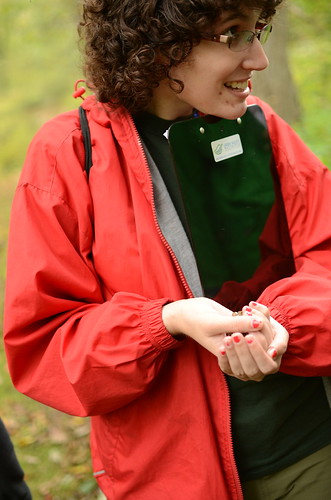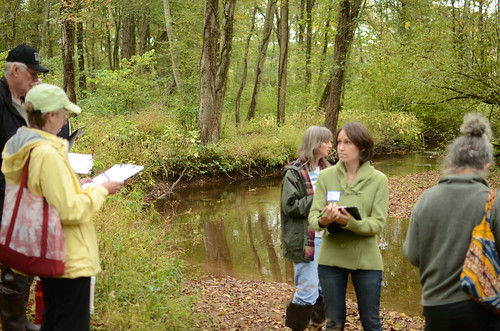Overview
Stormwater
Stormwater is rainwater that picks up pollutants from impervious (impermeable, hard) surfaces, such as parking lots, roads, buildings, and sidewalks, and transports them to local waterways - many times through storm drains. Stormwater is a major concern throughout the entire Schuylkill River Watershed, especially in highly developed areas and with increased storm events due to climate change.
 The Stormwater Workgroup works to improve stormwater management by implementing best management practices (BMPs), such as naturalized basins, rain gardens, bioswales, rain barrels, riparian stabilizations, and more. The workgroup partners with nonprofits, municipalities, government agencies, water suppliers, and other watershed organizations to implement these BMPs. The workgroup also partners with schools to implement BMPs through the Schuylkill Action Students. Find more materials and resources using the links below!
The Stormwater Workgroup works to improve stormwater management by implementing best management practices (BMPs), such as naturalized basins, rain gardens, bioswales, rain barrels, riparian stabilizations, and more. The workgroup partners with nonprofits, municipalities, government agencies, water suppliers, and other watershed organizations to implement these BMPs. The workgroup also partners with schools to implement BMPs through the Schuylkill Action Students. Find more materials and resources using the links below!
Materials:
- A Guide to Stormwater Management on School Campuses
- Example Stormwater Management Plan: The Montessori School
- Homeowner's Stormwater Handbook
- Naturalizing Your Yard: Improving your Yard's Ecology while Saving Money
- PEC Overview of Municipal Stormwater Fee Programs
- PennFuture: Funding Stormwater Management in Pennsylvania Municipalities
- Pennsylvania Stormwater Best Management Practices Manual
- PSU Rain Barrel Information and Guide
- Rain Garden Brochure
- Schuylkill Schools Geodatabase for ArcMap (a prioritization tool for schools working to improve stormwater management).
Links to partner resources:
- Green infrastructure resource library at ConservationTools.org
- Comprehensive MS4 Resource from the US Water Alliance
- DCNR green stormwater infrastructure webpage
- EPA green infrastructure webpage
- Montgomery County Conservation District Stormwater Resources listed by area of interest
- nonpointsourcepa.org (educational resources and funding opportunities for agriculture, AMD, stream restoration, and stormwater projects)
Presentations:
- Rain Garden Maintenance by Chris Obropta, Rutgers (slides, recording) 12-2-2020
- GSI Maintenance by Kate Henry, EGI (slides, recording) 12-2-2020
Workgroup Chairs: Alex Cupo (Sustainable Business Network of Greater Philadelphia) and Zach Nemec (Pennsylvania Sea Grant)
Gallery
Projects
Schuylkill Headwaters Association partnered with Blue Mountain Middle School to retrofit existing stormwater features into rain gardens.
A stream restoration project was installed at Brookside Country Club as part of the Schuylkill Watershed Initiative Grant.
Montgomery County Conservation District worked with Christopher Dock High School in Towamencin Township to install a 1000 square-foot rain garden on the school’s campus to process stormwater from a parking lot and athletic fields.
Conrad Weiser Middle School worked with Berks County Master Watershed Stewards and other volunteers to retrofit a grassy area with native plants. The students helped with researching what native plants and pollinators to use.
Wissahickon Sustainability Council partnered with the Philadelphia Water Department, Schuylkill Center for Environmental Education, and Community Design Collaborative to develop a green master plan for the school.
Click here for more information about the master plan.
In 2011, an acre of turf grass was converted to meadow, and 200 riparian buffer trees were planted along Stony Creek with TreeVitalize funding. The project restored a primary headwater stream, Stony Creek, before it flows into the Schuylkill River, by stabilizing eroding streambank, installing energy dissipaters upstream of the eroded areas, converting 1.4 acres of turf grass into deep-rooted meadow, and planting over one acre of riparian buffer.
Germantown Academy completed a master plan in 2011, with the goal of reconnecting the school with the natural environment. Environmental features include restored wetlands, ponds, wet meadows, woodlands, and walking trails. The school planted a rain garden and also has a green roof.
In 2012, Germantown Academy earned the Montgomery Award for environmentally sensitive site planning, sustainable building design, and restoration of natural features. For more information, click here.
The Green Lane Reservoir supplies drinking water to the town of East Greenville, but increased upstream development intensified stormwater runoff, and threatened to increase water quality impairment. A reforestation project took place to slow the destructive force and filter pollutants from the runoff.
Albert M. Greenfield School in Philadelphia greened its campus by removing an asphalt yard and transforming it into a stormwater management system.
Students and educators at Hereford Elementary School planted a 9,000 sq. ft. rain garden which treats runoff from the front parking lot and the roof on the front side of the school.
Berks Nature partnered with Kutztown Middle School to convert existing mowed turf area into an unmowed area, planted with 230 native trees and 100 native shrubs.
Along the perimeter of the school, 40 large trees were planted. A section of the parking lot was also planted with 9 trees. These native trees and shrubs help to protect the Saucony Creek, a subwatershed in the Maiden Creek Watershed.
Destination Schuylkill River partnered with the Partnership for the Delaware Estuary to install a rain garden at the Lankenau School in Philadelphia.
Students at Limerick Elementary School helped with planting a riparian buffer on their campus, along Landis Creek
The Friends of the Wissahickon (FOW) worked with the Partnership for the Delaware Estuary, students, teachers, and FedEx school employees to install a rain garden at Lingelbach Elementary School, which will treat stormwater before it enters Monoshone Creek.
Working on two school campuses bordering a full mile of the Stony Creek,The NASD improved stormwater management by restoring a riparian buffer and retrofitting two retaining basins.
An eroding stream bank was stabilized and replanted using erosion-control tubes filled with a composted growing medium. Despite being under water several times, the fully vegetated berm is holding strong and continues to protect the Stony Creek from erosion at this site.
Green Valleys Watershed Association designed and installed a bioswale vegetated channel in front of the Phoenixville Area Middle School’s cafeteria windows, with hands-on help from middle school students.
The Partnership for the Delaware Estuary and Montgomery County Conservation District partnered to retrofit a failing rain garden into an improved bioretention area, filled with native shrubs. School district maintenance staff completed construction under the direction of the District Watershed Specialist. Then, the Partnership for the Delaware Estuary teamed up with a science teacher to lead students in planting the garden. Funding was provided through a grant from 3M, awarded to the Partnership for the Delaware Estuary.
A pervious parking lot and bio-infiltration areas were installed to slow and filter stormwater runoff to Saw Mill Run, a direct tributary to the Schuylkill River.
Berks Nature worked with Robeson Elementary Center to eliminate mowing from a 2.6 acre area of the campus. The area was reseeded with native seeds and planted with native trees and shrubs. Addtionally, blacktop was removed from a 1,200 square foot area of the parking lot and graded to collect stormwaterrunoff. An 800 square foot pollinator garden was also added to the site. These projects absorb and infiltrate stormwater running off into an unnamed tributary of the Hay Creek.
At Sandy Run Middle School in Dresher, more than 700 students were involved in a project to rip out invasive knotweed in Sandy Run and replace it with native trees and shrubs that will help restore the waterway.
Green Valleys Watershed Association worked with Schuylkill Elementary School to install a large rain garden on their campus.
One acre in size, a traditional detention basin on the school campus drained 65 acres of parking lots and playing fields. Retrofitting the large basin slowed stormwater runoff volume and pollution to the Mingo Creek.
Students transformed a paved traffic circle into a working rain garden, calming trqaffic problems and preventing heated parking lot runoff pollution from entering the Wissahickon Creek. Other rain gardens and student-created sculptural installations addressed runoff from the school roofs.
The Montessori School in Dresher, PA has installed a rain garden, rain barrels, downspout planters, and developed a green master plan.
The headwaters of Unami Creek was restored, with invasive species removed and a riparian buffer planted.
A riparian buffer, rain garden, and meadow were installed at the Upper Perkiomen High School.
Green Valleys Watershed Association worked with West Vincent Elementary School to naturalize an existing stormwater basin.
Related Documents
| Name | Upload Date | Download | View |
|---|---|---|---|
Campus Stormwater Guide |
January 9, 2018 | Download | View |
Homeowner's Stormwater Handbook |
January 9, 2018 | Download | View |
Rain Gardens Brochure |
January 9, 2018 | Download | View |
The Montessori School Master Plan 2017 |
July 17, 2018 | Download | View |
Manayunk Watershed Education - Kay Sykora |
September 5, 2018 | Download | View |
Transforming Philadelphia's Schoolyards GuideA guide to greening schoolyards and implementing green stormwater infrastructure. |
June 3, 2019 | Download | View |
Schuylkill Action Students brochure |
June 17, 2019 | Download | View |
MS4 Workshop: Agenda and Stormwater Grants Handout |
August 8, 2019 | Download | View |
MS4 Workshop: SAN Intro presentation |
August 8, 2019 | Download | View |
MS4 Workshop - PEC Funding & Financing Mechanisms presentation |
August 8, 2019 | Download | View |
MS4 Workshop - Pennvest Low Interest Loans & Grants presentation |
August 8, 2019 | Download | View |
MS4 Workshop - Schuylkill River Restoration Fund presentation |
August 8, 2019 | Download | View |
MS4 Workshop - Treevitalize presentation |
August 8, 2019 | Download | View |
MS4 Workshop - MCCD Technical Assistance & Funding Opp. presentation |
August 8, 2019 | Download | View |
Biochar Presentation by Gary Gilmore 6-11-2020 |
June 11, 2020 | Download | View |
Rain Garden Water Balance Presentation 6-11-2020 |
June 11, 2020 | Download | View |
Rain Garden Maintenance PresentationPresented at the SAN Stormwater Workgroup Meeting on 12-2-2020 by Christopher C. Obropta, Ph.D., P.E. from Rutgers Cooperative Extension. |
December 4, 2020 | Download | View |
Green Stormwater Infrastructure Maintenance Presentation Kate Henry |
December 4, 2020 | Download | View |
EPA FITS Webinar Slides |
March 31, 2022 | Download | View |
SRF 101 |
March 31, 2022 | Download | View |
Funding Natural Infrastructure Workshop FlyerFlyer for American Rivers Stormwater Funding Series Sprin 2022 |
April 7, 2022 | Download | View |
PennEnvio_Slides |
January 27, 2023 | Download | View |
Waterways Perceptions Survey Results Summary |
January 27, 2023 | Download | View |
2023 Bus Tour Itinerary |
August 21, 2023 | Download | View |
October 20 Workshop Agenda |
September 29, 2023 | Download | View |
2023 Stormwater Workshop Resources |
October 18, 2023 | Download | View |
Needs, Challenges, and Solutions for Green Stormwater Infrastructure (GSI) Implementation |
February 15, 2024 | Download | View |
SAN Stormwater Minutes 02.12.2024 |
February 20, 2024 | Download | View |
SAN Connections Spring 2024 |
May 13, 2024 | Download | View |
June 10th Venice Island and Flat Rock Dam Parking Instructions |
June 4, 2024 | Download | View |
June 10 Flat Rock Dam and Manayunk Canal Improvement Project |
June 11, 2024 | Download | View |
Bus Tour Itinerary 2024 |
July 26, 2024 | Download | View |

















































